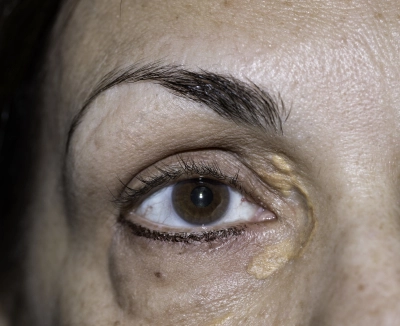 XANTHELASMA
XANTHELASMA
XANTHELASMA IS A YELLOWISH CHOLESTEROL DEPOSIT ON THE EYELID. BECAUSE THEY ARE CLEARLY VISIBLE, THEY CAN CAUSE STRESS FOR THE PATIENT. LUCKILY, XANTHELASMA CAN BE EASILY AND GENTLY TREATED. READ ON FOR MORE INFORMATION.
Photo: © DOUGLAS – stock.adobe.com
-
What is a Xanthelasma?
-
What are the causes of Xanthelasma?
-
What treatment is available for Xanthelasma?
-
How is aftercare of Xanthelasma? Can it recur after treatment?
-
How can I prevent Xanthelasma?
-
How much does treatment cost?
WHAT IS A XANTHELASMA?
Xanthelasma are yellow spots or nodules that appear on the upper or lower eyelids and are caused by cholesterol deposits stored in the skin. They usually occur near the inner corner of the eyelid. Sometimes there is only a single spot, but more Xanthelasma can appear over time, often symmetrically. In many cases, the Xanthelasma grow larger over the years.
The deposits can be caused by a metabolic disorder, but this is only the case in a small number of patients. Xanthelasma are often perceived as aesthetically unattractive and annoying because they are so clearly visible. Medically however, they are completely harmless.
WHAT ARE THE CAUSES OF XANTHELASMA?
Many patients develop Xanthelasma despite having normal blood lipid levels. In some cases, if the lipid levels are high, it is advisable to talk to your family doctor or request an internal check-up, because Xanthelasma could be an early warning of the onset of a metabolic disease.
WHAT TREATMENT IS AVAILABLE FOR XANTHELASMA?
There are a few options for treating Xanthelasma. Many patients have a drooping upper eyelid at the same time. In this case, the removal of the Xanthelasma could be carried out in conjunction with an upper eyelid lift. Procedures such as caustic and cryotherapy were used in the past, but often resulted in damage to the surrounding sensitive tissue and are now rarely practiced. The gold standard today is removal using an erbium or CO2 laser. The advantage of this method is that the affected areas are handled with such precision that the surrounding tissue is not damaged. A single treatment often leads to success.
HOW IS AFTERCARE OF XANTHELASMA? CAN IT RECUR AFTER TREATMENT?
Follow-up treatment is particularly important immediately after Xanthelasma has been removed. Localised bruising and some crusting can develop. This means that any treatment should be followed by a week of rest and recovery. In the consultation, a tailored healing plan and aftercare will be precisely determined. Permanent sun protection, along with avoidance of the sun and solariums, are important to prevent pigment changes.
HOW CAN I PREVENT XANTHELASMA?
In principle, Xanthelasma cannot be prevented. A healthy diet is generally recommended. In people with high blood lipids, a doctor should be consulted, and treatment prescribed to reduce the blood values, which will also help to avoid the onset of heart disease and strokes.
HOW MUCH DOES TREATMENT COST?
Depending on the findings, the cost of treatment starts at € 300 per session. As a rule, a single session is sufficient.
Book an appointment in our practice in Vienna



